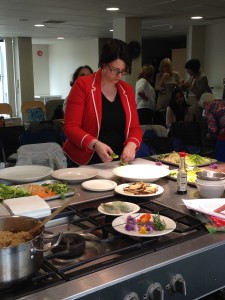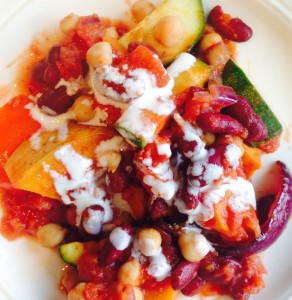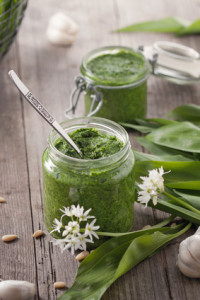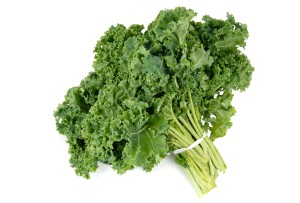We had a great day on Sunday cooking for the IHS students at Donnybrook Fair Cookery School. We love cooking at this great venue and 30 eager enthusiastic future dietary counsellors and nutritionists were there bright and early and ALL day long! In total we cooked up 18 dishes, which everyone got to taste. We started with sugar-free (and I mean honey/ maple syrup/ agave free too!) granola, went on to Asian noodle salads, Vietnamese spring rolls, Mexican style quinoa salad (all gluten, dairy, egg free) and many more in between. Sweet treats included homemade probiotic coconut yoghurt with a pomegranate and pineapple ‘salad’ and a delicious berry icecream.
Celebrate all things Veggie for Vegetarian Week
Time to celebrate all things veggie and get some inspiration! Do you get at least 5 portions of vegetables per day? Do you regularly eat pulses such as beans and lentils?
Eating 5 portions (or 7-10 if you can manage it!) of vegetables per day reduces your risk for chronic illness and ‘all-cause mortality’, which is death for any reason. Try to get a wide variety of colours in as they all have a different profile of vitamins, minerals and antioxidants. Include leafy green vegetables daily if you can too and try not to always rely on your old favourites. Next time you are standing in the vegetable aisle of your supermarket, have a look around and choose something you haven’t eaten in a while, or ever!
To celebrate vegetarian week I thought I’d share one of my favourite comforting recipes. It’s super easy too and very economical. Lots of fibre in the beans and chickpeas plus plenty of good quality protein will keep you full for longer too. If you have ever had ‘patatas bravas’ in a tapas restaurant, it has a similar flavour to that, except substituting nutritionally poor potatoes for tonnes of veg and pulses, it’s a win-win situation!
‘Veg’ Bravas serves 4
Ingredients
1 large sweet potato or 2 medium
1 butternut squash
1-2 courgette
1 red pepper
1 yellow/ orange pepper
1 red onion
(Any other vegetables as desired)
1 ½ 400g tin chopped tomatoes
1 400g tin kidney beans (or mixed beans, or any beans)
1 400g tin chick peas
Smoked paprika (to taste, but a lot!)
Pinch cayenne pepper or finely chopped fresh red chilli (optional)
2 clove garlic finely chopped or minced
½ tsp cinnamon
½ tsp dried oregano
Coconut oil
Salt and pepper to taste
For the aioli– mix mayonnaise with juice of ½ lemon and 1 clove of finely chopped garlic, add water until thinned out.
Method
- Preheat oven to 180oC
- Chop vegetables into chunks for baking. Keep ¼ red onion for the sauce.
- Sprinkle generously with smoked paprika and coat in a small amount of melted coconut oil.
- Bake until soft, approximately 30-40 mins at 180oC depending on the size of the veg, tossing half way through
- For the sauce, finely dice ¼ red onion and sauté with 1 clove of garlic and fresh red chilli (if using) in a small amount of coconut oil on a low heat for 5 mins
- Add 1 heaped tsp smoked paprika, ½ tsp cinnamon and ½ tsp oregano, also cayenne pepper if using, and cook for a further 2 mins
- Add 1 and ½ tins chopped tomatoes and bring to the boil. Allow the sauce to simmer gently until the vegetables are almost cooked. Add salt and pepper to taste.
- drain beans and chickpeas and rinse well. Add to sauce to heat through.
- Remove vegetables from the oven, stir through the beans and sauce.
- Serve with a drizzle of aioli
Enjoy and please share!
Coeliac Awareness Week
In Ireland we have a high incidence of the gene that increases your risk for coeliac disease, rising to over 50% of the population in the west of Ireland.
When you should get investigated for Coeliac Disease
- chronic diarrhoea (or constipation)
- bloating, wind, distended stomach
- pain, cramping
- unexplained anaemia
- unexplained osteoporosis
- family history of gluten intolerance, thyroid conditions, type I diabetes
In addition, there may be a large number of people who are sensitive to gluten, now termed ‘Non-coeliac gluten sensitivity’ or NCGS. The article cited below discusses how we need more research into this condition and as of yet the mechanism, cause or incidence is largely unknown. Common symptoms can include (and some of these may occur in true Coeliac disease also)
- tiredness
- fatigue
- headache or migraine
- fibromyalgia-like joint or muscle pain
- leg or arm numbness
- ‘brain fog’
- dermatitis or skin rash
- depression
- anxiety
Excluding gluten from your diet can be a bit of a challenge. Without proper nutritional direction, it may leave you at risk for deficiencies. Iron and calcium absorption can be reduced or altered in coeliac or gluten sensitivity and therefore you may already be at risk without further restricting your diet. In addition, true Coeliacs are at increased risk for osteoporosis and bowel cancer. Excluding gluten before a true diagnosis of Coeliac disease may lead to reduced monitoring of other conditions that may arise.
If you have are considering excluding gluten talk to us first. You need to be eating a gluten-containing diet for approximately 6 weeks before you can accurately test for Coeliac disease. If you are excluding gluten, we can ensure that your diet is well balanced.
Non-coeliac gluten sensitivity: piecing the puzzle together
Full article available at http://www.ncbi.nlm.nih.gov/pmc/articles/PMC4406911/
United European Gastroenterol J. 2015 Apr; 3(2): 160–165.
Biesiekierski & Iven
Abstract
The avoidance of wheat- and gluten-containing products is a worldwide phenomenon. While coeliac disease is well-established, much remains unknown about whether gluten can be a trigger of gastrointestinal and/or extra-intestinal symptoms in patients without coeliac disease. In this article, we discuss the latest scientific evidence and our current understanding for the possible mechanisms of this largely ambiguous group, termed ‘non-coeliac gluten sensitive’ (NCGS). We can conclude that NCGS should be regarded as an independent disease outside of coeliac disease and wheat allergy, and that the number of patients affected is likely to be limited. Many questions remain unanswered and it needs to be verified whether the elimination of dietary gluten alone is sufficient for the control of symptoms, and to understand the overlap with other components of wheat.
Wild Garlic
Those of you getting out and about in the country or near a wood or stream may have noticed the recent appearance of beautiful, white flowers that look just like white bluebells, but have a distinct garlicy whiff about them. This is wild garlic – healthy, free and tasty. For pictures and more information have a look on the wild and slow website here http://wildandslow.com/wp-content/uploads/2011/03/THE-WILD-GARLIC.pdf
Jut pick the leaves and stems, including the flowers. Like all wild food, it’s important to just take what you need and leave the rest for others and for next year. A word or warning, don’t confuse wild garlic for lily of the valley, which looks a little similar, but is not edible.
To be sure of what you are picking, rub a leaf between your fingers and smell. You should be clearly able to smell garlic. If not, don’t pick it.
I like to blend the leaves and stems with some good Irish butter and black peppercorns to make wild garlic butter. This can be stored in the fridge for a week or so and in the freezer for a couple of months. It’s great dotted on fish before baking and also great for stirfrying some torn up kale and chickpeas for a speedy dinner.
The flowers make a beautiful and tasty addition to salads and taste a little like chive flowers.
One of my favourite ways to use wild garlic is to make pesto from the leaves and stems. This tastes great tossed through wholegrain pasta, cooked quinoa or ‘courgetti’ (courgette noodles). It’s also great as a spread on wholegrain pitta or used to top cod or other white fish. Best of all, it only takes a few minutes to make. Take 3 large handfuls of fresh wild garlic, wash VERY well, roughly chop and blend in a food processor with a cup of walnuts or cashew nuts and a cup of grated parmesan cheese. Blend for a minute, scrape down the processor, then add
1/2 – 1 cup extra virgin olive oil and continue to blend until a smooth paste is formed. Store in sterilised jars and cover the pesto with a layer of olive oil to keep fresh.
We would love to hear your ideas for using wild garlic too, so please share!
Magnesium – why do I need it?
Magnesium is an essential element which takes part in hundreds of important biochemical reactions in the body. It is found in green leafy vegetables, legumes, nuts, seeds and whole grains. Due to food processing techniques, much magnesium is stripped from our foods, such as in the removal of the fibrous portion when refining white flour. There may be a significant number of people with magnesium deficiency, particularly those that eat a lot of processed or convenience foods.
Symptoms of magnesium deficiency include
- Fatigue, weakness
- Loss of appetite, nausea, vomiting
- Numbness, tingling, ‘pins and needles’
- Muscle spasms, cramps
- Restless legs
- Abnormal heart rhythms
- Personality changes
Magnesium deficiency is an important risk factor for type II diabetes, cardiovascular disease, stroke, osteoporosis, migraine including menstrual migraine and PMS. Magnesium is also essential for the developing foetus and deficiency can be linked to gestational diabetes, pre-eclampsia and negative effects in the child in later life.
Magnesium supplements can be used to increase magnesium levels in conjunction with dietary changes. However, not all supplements are easily absorbed by the body. Magnesium oxide, often found in cheaper multivitamins, is difficult to absorb with only 6% being usable by the body. Magnesium citrate on the other hand is much easier for your body to use, with up to 97% being utilised.
The most common measurement of magnesium carried out uses serum, which is a portion of your blood. This is a very inaccurate measurement. Magnesium is essential to maintain your heart rhythm. The ‘reservoir’ or store in your bone is released into your blood during times of deficiency to keep your heart beating correctly. Thus you may be losing magnesium from your bone and be unaware of this. A more accurate measurement is to look at the levels inside your red blood cells. This is a better indication of your magnesium levels over time.
Here at Glenville Nutrition we measure red blood cell magnesium and can advise you how to improve your magnesium levels using diet and supplements. Call us to find out more on 01-4020777. For further information on magnesium, read this fact sheet from the NIH: http://ods.od.nih.gov/factsheets/Magnesium-HealthProfessional/
- « Previous Page
- 1
- …
- 6
- 7
- 8
- 9
- 10
- Next Page »





